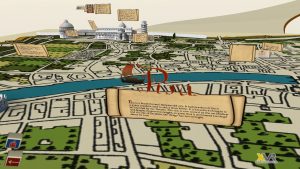
ACDH Lecture 2.3: this lecture was presented for the Vienna Academy 24. October 2016 – 17:00
How is the use of Virtual Reality technology challenging the museum-library sector? The case of the University Museum and Library of Trondheim, Norway.
Museums and libraries were created as repositories of memory, initially as rarity-cabinets and archives by rich collectors in the 16th century. These resulted in the museum and library archives as public institutions of the 18th century with a mission to educate their visitors (Dilevko 2004). During the 19th century the past was defined as the product of “intellectual enactment and study” (Benett, 2004, p.2). Today, the use of Virtual Reality (VR) applications in Archaeology and Museology and the ever-increasing development of interactive software and new technological platforms have provided museum and library archives and historical collections with a new space of contact to their users. In other words, Museums, libraries and institutions of memory are challenged to find new forms of dialogue with their users and have turned to VR technology to entertain and inform their audience.
Hooper-Greenhills (2000) theoretical approach to visitor experience provides us with the argument that we cannot simply impose pre-selected narratives to the visitors and expect a consistent response. Each individual will have his own experiential perception according to his own individualized level of pre-understanding. That is the visitor`s background, nationality and identity may influence and vary the outcome of the experience to be expected. Thus the visit becomes “a complex process of interpretation” (Hooper-Greenhill 2000:138). In modern archaeology there is a view, that archaeologists as academic professionals cannot be separated from the society they live in, when working in communities or museums (Holtorf 2012). Public perception and interpretation of memory manifests itself with popular engagement that follows its own rules and have to be taken into account by researchers.
A series of projects claim that VR applications create digital involvement by active participation, and enhance learning through a cognitive dialogue with the user, but the mediator of the knowledge is still very central in conveying the message and engage the public (Styliani, 2007, Sanders 2009, Gabellone 2009). Others claim that the creation of environments where VR technological tools are employed by free choice allow the visitors to contribute their own narratives and interpretations of the objects and contexts (Champion 2009, Sylaiou 2004).
The main question I posed with this lecture was whether the introduction of VR tools in dissemination practices has led to a change in the experience of the contemporary museum perception. By using the case of the Archaeological Museum and library I work at, I will look into the changes on the professional level that have taken place, in the process of adapting VR technologies for creating outreach activities.
Project Mubilhttp://mubil.no/
Alexandra Angeletaki’s profile at NTNU Library: http://www.ntnu.edu/employees/alexandra.angeletaki
Alexandra Angeletaki’s blog: https://www.ntnu.no/blogger/ub-arkeologi/
